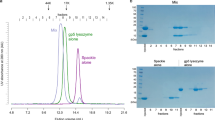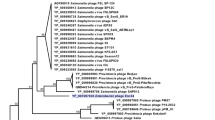Abstract.
The kinetic, thermodynamic and structural stability of gp36C, the virion-associated peptidoglycan hydrolase domain of bacteriophage ϕKMV, is analyzed. Recombinant gp36C is highly thermoresistant (k = 0.595 h−1 at 95°C), but not thermostable (Tm = 50.2°C, ΔHcal = 6.86 × 104 cal mol−1). However, aggregation influences kinetic stability in an unusual manner since aggregation is more pronounced at 55°C than at higher temperatures. Furthermore, gp36C reversibly unfolds in a two-state endothermic transition, and circular dichroism analysis shows that gp36C almost completely refolds after a 3-h heat treatment at 85°C. These properties are in agreement with gp36C being part of the extensible tail which is ejected in an unfolded state during phage infection.
Similar content being viewed by others
Author information
Authors and Affiliations
Corresponding author
Additional information
Received 24 April 2006; received after revision 26 May 2006; accepted 10 June 2006
Rights and permissions
About this article
Cite this article
Briers, Y., Lavigne, R., Plessers, P. et al. Stability analysis of the bacteriophage ϕKMV lysin gp36C and its putative role during infection. Cell. Mol. Life Sci. 63, 1899–1905 (2006). https://doi.org/10.1007/s00018-006-6183-7
Published:
Issue Date:
DOI: https://doi.org/10.1007/s00018-006-6183-7




